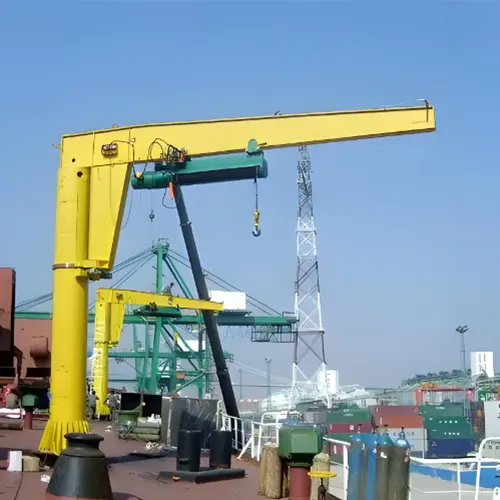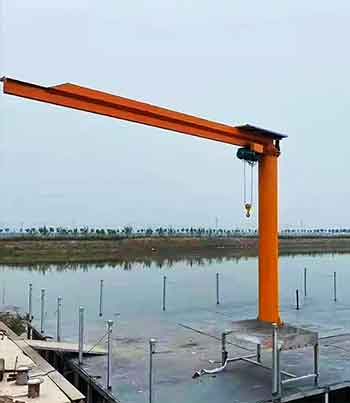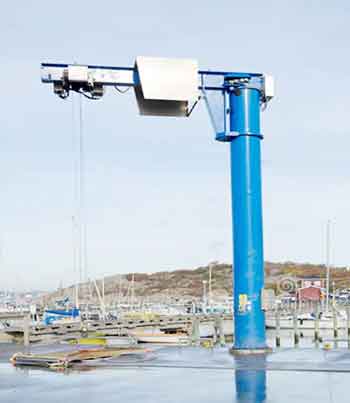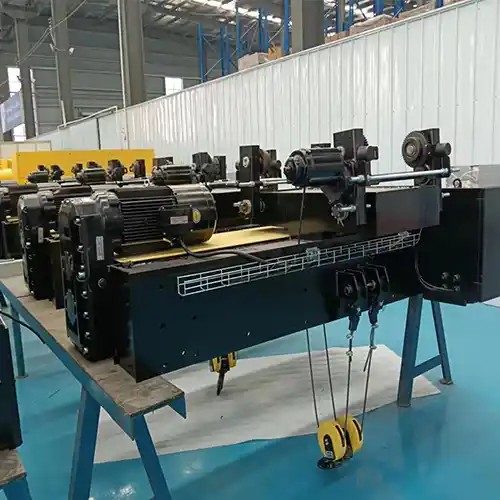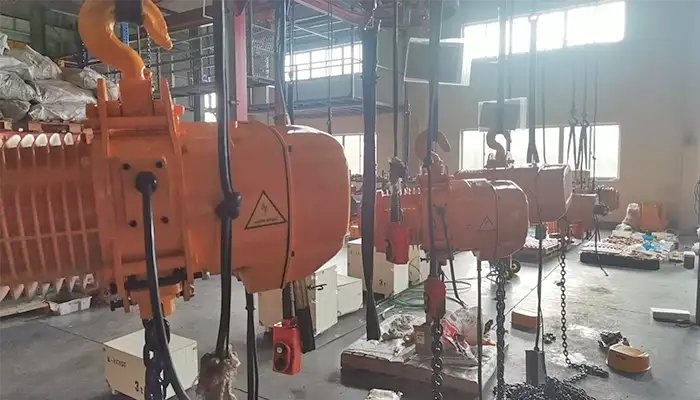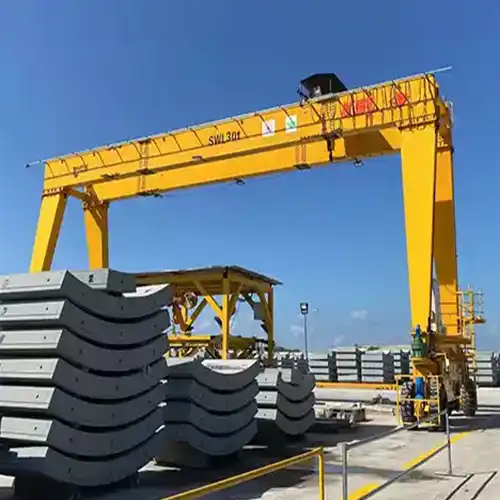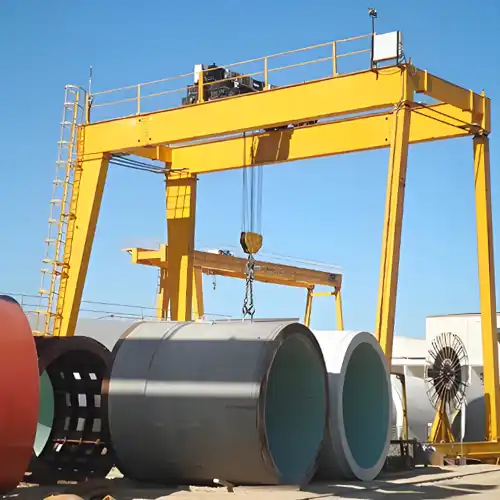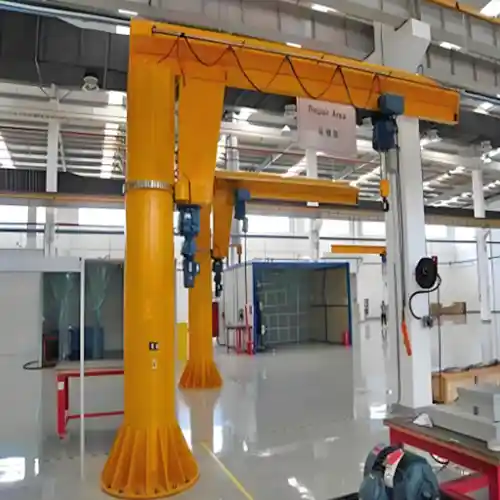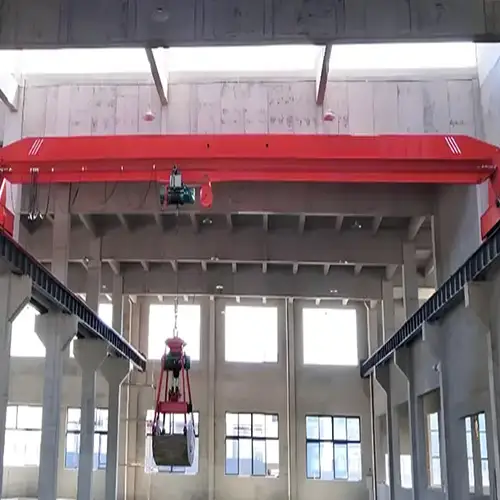Anti-Corrosion Jib Cranes 3 to 16 Ton Excel in Harsh Conditions
Anti-corrosion jib cranes excel in harsh conditions by ensuring stability, precise lifting, and adaptability to various load sizes, enhancing reliability
| Crane Type | Pillar jib crane with anti-corrosion- design |
| Crane Capacity | 1 ton to 16 ton |
| Lifting Height | As your request |
| Crane Span | As your request |
| Note | Customized anti-corrosion cranes are provided based on your specifications |
Category: Hazardous Environment Cranes
Your Trusted Anti-corrosion Crane Manufacturer & Supplier
Anti-Corrosion Jib Cranes 3 to 16 Ton Excel in Harsh Conditions
Industrial Jib Crane for Sale, Custom Jib Crane with Anti-Corrosion Jib Cranes for Harsh Industrial Uses
Anti-corrosion jib cranes excel in harsh conditions by ensuring stability, precise lifting, and adaptability to various load sizes, enhancing reliability
Overview of Anti-Corrosion Jib Cranes
Anti-corrosion jib cranes are specialized lifting devices designed to operate reliably in environments prone to high levels of moisture, salt, and other corrosive elements. Unlike standard jib cranes, these cranes are equipped with advanced materials and protective coatings to prevent damage from rust and corrosion. Their primary purpose is to provide efficient and safe lifting solutions in conditions where traditional cranes would quickly deteriorate.
In environments like ports, harbors, and industrial sites with high humidity or exposure to corrosive substances, the durability and longevity of equipment are critical. Anti-corrosion jib cranes are engineered to meet these challenges head-on. Their robust construction and corrosion-resistant features ensure consistent performance and minimal downtime, even in the harshest conditions.
These cranes are not only vital for maintaining operational efficiency but also for ensuring safety and reducing maintenance costs. By utilizing anti-corrosion technology, these cranes extend the operational life of the equipment, making them a valuable investment for facilities that face challenging environmental conditions.
Corrosion Challenges in Harsh Conditions
Impact of Harsh Environments
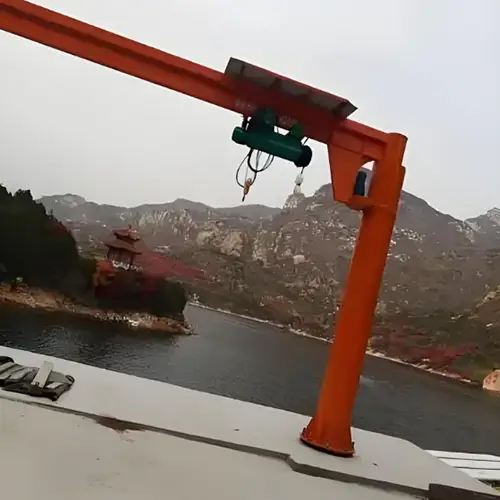
Coastal Areas:In coastal regions, the primary corrosion threat arises from saltwater, which accelerates rust and deterioration. Salt and moisture can significantly impact metal structures, leading to the rapid degradation of unprotected equipment. Jib cranes operating in these areas must contend with the challenge of maintaining functionality and safety in a highly corrosive environment. The salty air and water act as catalysts for electrochemical reactions that expedite the rusting process, particularly on exposed metal surfaces. To combat this, anti-corrosion designs often include marine-grade coatings, stainless steel components, and sealed joints that prevent saltwater infiltration. These measures not only protect the crane but also ensure that it can operate safely and efficiently, even in the harsh conditions typical of coastal regions.
Industrial Environments with Chemicals:Industrial settings that handle chemicals or corrosive substances present another significant challenge to the durability of cranes. Fumes, chemical spills, and airborne particles can corrode metal surfaces, weakening the crane's structure over time and compromising its load-bearing capacity. In such environments, specialized anti-corrosion treatments are crucial. These treatments often involve the application of chemical-resistant coatings, galvanization, and the use of non-metallic materials in critical components. Additionally, cranes may be designed with protective barriers or enclosures to shield sensitive parts from direct exposure to corrosive agents. Regular maintenance and inspections are also essential to detect and address early signs of corrosion, ensuring the crane's longevity and reliability in chemically aggressive environments.
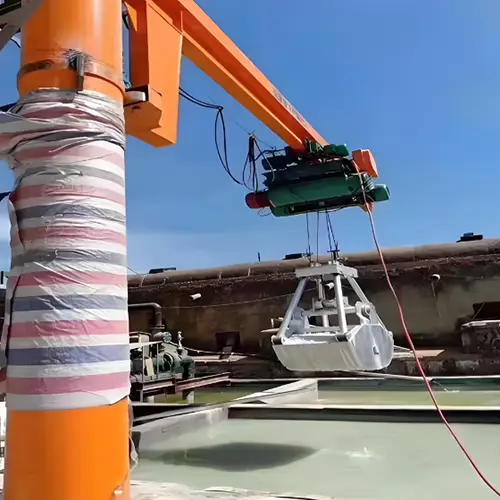

Extreme Temperatures and Humidity:Extreme temperatures and high humidity levels can exacerbate corrosion issues, posing additional challenges for crane operation. Hot and humid conditions often lead to the formation of condensation on metal surfaces, accelerating rusting and the degradation of metal parts. Conversely, freezing temperatures can cause metal to become brittle, increasing its susceptibility to damage and corrosion. Anti-corrosion jib cranes designed for such environments incorporate materials and coatings that can withstand temperature fluctuations and high humidity. For instance, corrosion-resistant alloys, specialized paints, and thermal barrier coatings are commonly used to protect against the effects of condensation and temperature-induced stress. These cranes are also engineered to maintain their structural integrity and performance across a wide range of environmental conditions, ensuring safe and efficient operation in both hot, humid climates and cold, icy regions.
Consequences of Corrosion
- Structural Integrity:Corrosion can have a severe impact on the structural integrity of cranes. As metal components corrode, they undergo a process of oxidation, which weakens the material, leading to a reduction in strength and stability. This degradation can result in mechanical failures, such as cracks, fractures, or even catastrophic collapse in extreme cases. The crane's lifting capacity may be compromised as the corroded components lose their ability to bear heavy loads, making the equipment less reliable and more dangerous to operate. Additionally, corrosion can affect the precision and alignment of moving parts, leading to operational inefficiencies and further exacerbating the risk of failure. To maintain safe operational standards, it is crucial to employ anti-corrosion technology that protects these critical components and preserves the crane's structural integrity.
- Maintenance and Safety Concerns :Corrosion significantly increases the maintenance demands of cranes. Regular inspections become necessary to detect and address corrosion before it leads to severe damage. Parts that are affected by corrosion must be repaired or replaced, which not only adds to operational costs but also causes downtime, reducing overall productivity. The frequent need for maintenance interrupts operations and requires resources that could be better utilized elsewhere. Furthermore, the safety concerns associated with corroded cranes cannot be overstated. As the integrity of the crane is compromised, the risk of accidents, such as load drops or structural failures, increases, endangering both workers and the surrounding environment. Anti-corrosion jib cranes mitigate these risks by reducing the likelihood of rust and deterioration. This not only extends the lifespan of the equipment but also ensures a safer working environment, as the chances of unexpected breakdowns or failures are minimized. Investing in anti-corrosion measures is therefore a proactive approach to maintaining both the safety and efficiency of crane operations.
Your Trusted Anti- Corrosion Pillar Crane Manufacturer & Supplier
Anti-Corrosion Pillar Jib Cranes for Sale
Anti-corrosion pillar jib cranes are designed specifically for environments where exposure to moisture, chemicals, and extreme weather conditions could lead to corrosion. These cranes are ideal for industries such as marine, chemical processing, and outdoor construction, where maintaining the integrity and longevity of equipment is crucial.
Key Features of Anti-Corrosion Jib Cranes
Material and Coating Technologies
- Corrosion-Resistant Materials :Anti-corrosion jib cranes are built using materials specifically chosen for their resistance to rust and deterioration. Stainless steel, galvanized steel, and high-strength aluminum alloys are common choices. These materials are selected for their ability to withstand corrosive elements like saltwater, chemicals, and humidity, ensuring the crane's longevity and consistent performance in harsh environments.
- Protective Coatings and Treatments:In addition to using corrosion-resistant materials, anti-corrosion jib cranes are treated with protective coatings. These coatings include epoxy paints, zinc-rich primers, and powder coatings, which create a barrier against moisture and corrosive agents. Regular maintenance of these coatings is crucial, as they protect the underlying metal from rust and damage. Some cranes also receive additional treatments, such as anodizing or thermal spraying, to further enhance their resistance to corrosion.
Design Considerations
- Weatherproofing :Anti-corrosion jib cranes are designed with weatherproofing features to ensure they function effectively in various environmental conditions. This includes the use of weather-resistant seals, covers, and enclosures that protect sensitive components from exposure to rain, snow, and extreme temperatures. By incorporating these features, the crane's operational reliability is maintained even in the most challenging weather conditions.
- Sealed Components:To prevent moisture and contaminants from infiltrating critical areas, anti-corrosion jib cranes are designed with sealed components. This includes waterproofing for electrical connections, lubricants that resist water washout, and seals on joints and bearings. These measures help to maintain the crane's internal mechanisms in good working condition, reducing the risk of corrosion-related failures and extending the equipment's service life.
Main Specifications of Anti-corrosion Pillar Jib Cranes
- Capacity: 1 ton to 16 tons, with variations depending on the model and application.
- Height of Lift: Customizable based on the height of the facility; typically designed to handle lifting requirements specific to the operational environment.
- Jib Length: Ranges from 2 meters to 10 meters, depending on the model; adjustable length for versatile load handling.
- Rotation: 360-degree rotation or limited rotation (e.g., 180 degrees) based on application needs.
- Material: Constructed from corrosion-resistant materials such as stainless steel, galvanized steel, or coated with anti-corrosion treatments.
- Design: Typically features a robust and durable design to withstand harsh environments; includes reinforced structures to handle high loads.
- Base Type: Available with floor-mounted, wall-mounted, or column-mounted bases to fit various installation requirements.
- Power Source: Can be manual, electric, or pneumatic, depending on the crane's application and operational needs.
- Controls: Equipped with ergonomic control systems, including push-button controls or remote controls for ease of operation.
- Safety Features: Includes overload protection, emergency stop buttons, and safety sensors to ensure safe operation.
- Finish: Anti-corrosion coatings or treatments to protect against rust and deterioration, suitable for marine, chemical, and other corrosive environments.
- Operational Temperature Range: Designed to operate effectively within a specified temperature range, which can be customized for extreme temperatures if required.
- Maintenance: Low-maintenance design with easily accessible parts for routine checks and servicing.
- Compliance: Adheres to relevant industrial standards and regulations for safety and performance.
Load Handling Capabilities of Anti-corrosion Jib Cranes
Common Load Capacities (1 Ton to 16 Ton Capacity):Anti-corrosion jib cranes come in various capacities to meet the diverse needs of port and harbor operations. Common load capacities range from 1 ton to 16 tons, though some models can handle even heavier loads. The specific capacity required depends on the types of cargo and materials being handled, as well as the operational demands of the facility.
Anti-corrosion jib cranes with capacities ranging from 1 ton to 16 tons are versatile lifting solutions designed to handle a wide array of loads in challenging environments, such as ports, industrial plants, and marine facilities. Here's a detailed look at the typical loads these cranes can manage:
1 to 3 Ton Capacity
Palletized Goods:
- Weight: Typically 500 kg to 2 tons per pallet.
- Examples: Food supplies, packaging materials, small machinery, and maintenance tools.
- Applications: Loading and unloading small boats, warehouses, and light industrial operations.
Small Containers and Drums:
- Weight: 200 kg to 1.5 tons per container or drum.
- Examples: Chemical drums, oil barrels, small storage containers.
- Applications: Transferring hazardous or sensitive materials in chemical plants and refineries.
Mechanical Parts and Components:
- Weight: 1 to 5 tons per component.
- Examples: Small motors, pumps, valves, and piping sections.
- Applications: Used in repair yards, manufacturing plants, and maintenance workshops.

4 to 6 Ton Capacity
Larger Pallets and Bulk Bags:
- Weight: 2 to 5 tons.
- Examples: Bulk bags of grain, cement, minerals, or fertilizers.
- Applications: Bulk material handling in ports, agricultural facilities, and construction sites.
Medium-Sized Machinery and Equipment:
- Weight: 3 to 6 tons per piece.
- Examples: Compressors, generators, and industrial machines.
- Applications: Assembly lines, heavy equipment maintenance, and machinery installation.
Intermediate-Sized Containers:
- Weight: 3 to 5 tons per container.
- Examples: Standard-sized ISO containers (less than full capacity), large chemical tanks.
- Applications: Port operations, chemical plants, and manufacturing facilities.

7 to 10 Ton Capacity
Heavy Machinery Components:
- Weight: 5 to 8 tons per component.
- Examples: Large motors, heavy-duty pumps, and industrial transformers.
- Applications: Power plants, heavy machinery manufacturing, and large-scale maintenance projects.
Industrial Equipment and Plant Components:
- Weight: 6 to 10 tons.
- Examples: Heat exchangers, large valves, HVAC systems.
- Applications: Petrochemical plants, refineries, and industrial processing facilities.
Oversized Pallets and Containerized Loads:
- Weight: 7 to 10 tons.
- Examples: Custom-built containers, large bulk bags, oversized pallets with construction materials.
- Applications: Construction sites, large warehouses, and industrial ports.
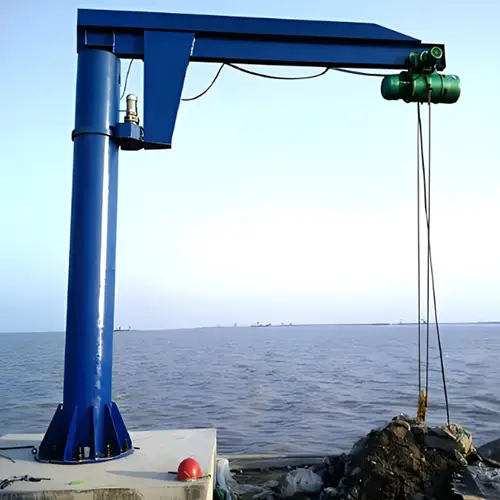
11 to 16 Ton Capacity
Large Shipping Containers:
- Weight: 10 to 15 tons.
- Examples: Fully-loaded 20-foot containers, partially loaded 40-foot containers.
- Applications: Port operations, large-scale distribution centers, and freight terminals.
Heavy Industrial Equipment:
- Weight: 12 to 16 tons per unit.
- Examples: Large industrial presses, boilers, and heavy construction machinery.
- Applications: Heavy industry, large construction projects, and infrastructure development.
Specialized Loads:
- Weight: 10 to 16 tons.
- Examples: Large fabrication parts, structural steel sections, and specialized industrial products.
- Applications: Steel plants, shipyards, and custom manufacturing operations.
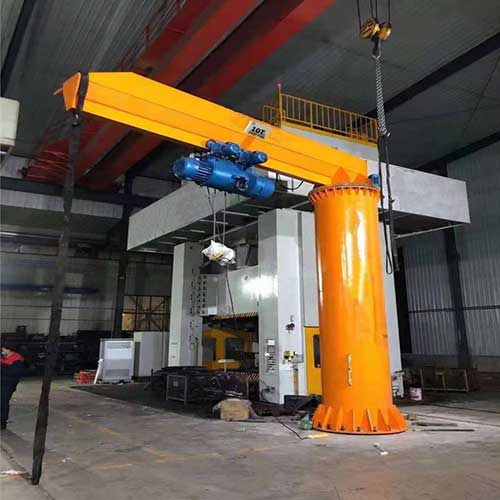
Benefits of Anti-Corrosion Design for These Capacities
- Durability: Anti-corrosion coatings protect the crane from rust and deterioration, even when lifting heavy loads in harsh environments.
- Safety: Enhanced corrosion resistance ensures that the crane maintains its structural integrity, reducing the risk of failure when handling high-capacity loads.
- Reduced Maintenance: Anti-corrosion cranes require less frequent maintenance, even under heavy-duty use, leading to lower operational costs and less downtime.
Anti-corrosion jib cranes with capacities ranging from 1 ton to 16 tons are essential tools in various industrial and marine settings. They are designed to handle a wide variety of loads, from light pallets and small machinery to heavy containers and industrial equipment. The anti-corrosion design ensures that these cranes remain reliable and safe, even in the most challenging environments.
Performance in Harsh Conditions
Stability and Lifting Precision:
- Engineered for Stability: Anti-corrosion jib cranes are meticulously designed to maintain stability in challenging environments. Their construction includes reinforced supports and robust structural components that provide a solid foundation, ensuring safe and stable operations.
- Advanced Control Systems: Equipped with sophisticated control systems that enhance precision during lifting operations. These systems facilitate smooth and accurate handling of loads, minimizing deviations and ensuring reliable performance.
- Safe Handling: The stability provided by these cranes is crucial for managing heavy or awkwardly shaped loads. By ensuring precise lifting and lowering, the cranes reduce the risk of accidents and equipment failure, contributing to a safer working environment.
Adaptability to Varying Load Sizes:
- Adjustable Lifting Mechanisms: Anti-corrosion jib cranes feature adjustable lifting mechanisms that allow them to handle a wide range of load sizes and types. This flexibility is essential for accommodating different shapes and weights of cargo.
- Versatile Load Handling: The cranes are designed with versatile load handling options, enabling them to manage various types of loads efficiently. This adaptability is particularly beneficial in dynamic port and harbor environments where load requirements can frequently change.
- Enhanced Productivity: By effectively managing diverse loads, anti-corrosion jib cranes contribute to the overall flexibility and productivity of port operations. Their ability to quickly adapt to different loading conditions helps streamline operations and improve operational efficiency.
This enriched description underscores the key aspects of anti-corrosion jib cranes' performance in harsh conditions, emphasizing their stability, precision, and adaptability to varying load sizes. These features enhance their effectiveness and reliability in demanding environments, supporting safe and efficient operations.
Your Trusted Anti-corrosion Crane Manufacturer & Supplier
Industrial Applications, Environments, and Functions of Anti-Corrosion Jib Cranes
Anti-corrosion jib cranes, designed to handle capacities from 1 ton to 16 tons, play a vital role in various industrial settings. Here's a comprehensive overview of their applications, environments, and functions:
Marine and Port Operations
Environment: Coastal areas, shipyards, and docks face unique challenges due to their high exposure to saltwater, humidity, and fluctuating temperatures. These conditions accelerate corrosion and require equipment that can withstand these harsh environments while maintaining reliability and performance.
Applications:
Loading and Unloading Small Vessels:
- Goods Transfer: Efficiently handles the transfer of various cargo such as pallets, containers, and equipment between boats and docks. This includes both small and large items, requiring precise lifting and positioning.
- Versatility: Capable of adapting to different types of vessels and cargo sizes, enhancing operational flexibility.
- Operational Efficiency: Reduces turnaround times and enhances productivity by streamlining loading and unloading processes.
Maintenance and Repairs:
- Boat Component Handling: Facilitates the lifting and positioning of boat components, engines, and other heavy parts during maintenance and repairs. This includes moving items into workshops or onto specialized repair stands.
- Tool Management: Provides a stable platform for handling and organizing maintenance tools and equipment, improving efficiency in repair tasks.
- Safety: Ensures that maintenance operations are conducted safely by providing reliable and precise lifting capabilities.
Handling Bulk Materials:
- Material Transfer: Moves bulk materials such as grains, coal, and chemicals from ships to storage facilities or processing areas. This application often involves handling large quantities and requires robust lifting solutions.
- Customized Attachments: Often equipped with specialized attachments or bucket grabs for efficient handling of different types of bulk materials.
- Operational Reliability: Maintains consistent performance in demanding environments, ensuring that material handling operations run smoothly.
Functions:
Precision Lifting:
- Safe Handling: Guarantees the safe and precise handling of loads, reducing the risk of damage to both the cargo and the crane. This is crucial in the confined and often congested spaces of docks and ship decks.
- Adjustable Reach: Features adjustable jib lengths and rotation angles to accommodate various lifting needs and operational scenarios.
- Enhanced Maneuverability: Provides the flexibility to maneuver around obstacles and access tight spaces, improving overall operational efficiency.
Corrosion Resistance:
- Durability: Constructed with corrosion-resistant materials and coatings to withstand the effects of saltwater and humidity. This includes materials like stainless steel or galvanized steel, which offer enhanced protection against rust and deterioration.
- Maintenance Reduction: Minimizes the frequency and extent of maintenance required, leading to lower operational costs and extended service life. Regular inspections and protective coatings further enhance the crane's longevity.
- Robust Design: Engineered to endure the harsh marine environment, ensuring reliable performance and safety even in the most demanding conditions.
Additional Considerations:
- Environmental Impact: Designed with features to minimize environmental impact, such as energy-efficient motors and low-noise operation, contributing to greener port operations.
- Weather Resistance: Built to operate effectively under various weather conditions, including rain, high winds, and extreme temperatures, ensuring year-round functionality.
- Safety Enhancements: Equipped with advanced safety features like overload protection, emergency stop buttons, and safety sensors to prevent accidents and ensure safe operation.
This enhanced description highlights the crucial roles and functions of anti-corrosion jib cranes in marine and port operations, emphasizing their importance in handling various tasks efficiently and safely.
Chemical and Petrochemical Plants
Environment: These facilities are characterized by exposure to highly corrosive chemicals, volatile fumes, and potential spills. The environment demands equipment that can endure harsh chemical conditions and provide reliable performance without compromising safety.
Applications:
Material Handling:
- Chemical Containers: Efficiently moves chemical drums, tanks, and containers within the plant, handling various sizes and weights. This includes both bulk chemicals and smaller, more manageable containers.
- Safe Transfer: Ensures safe and controlled transfer of hazardous materials, reducing the risk of spills or accidents.
- Efficient Workflow: Streamlines the movement of materials from storage to processing areas, enhancing operational efficiency.
Equipment Installation:
- Heavy Machinery: Assists in lifting and positioning heavy equipment such as pumps, valves, and compressors during installation or maintenance.
- Precision Placement: Provides precise control over equipment placement, which is crucial for maintaining system integrity and operational efficiency.
- Maintenance Support: Facilitates the replacement and servicing of critical plant components, ensuring continuous operation and reducing downtime.
Production Support:
- Raw Material Transfer: Moves raw materials between different stages of production, ensuring smooth and efficient processing workflows.
- Product Handling: Assists in the transfer of finished products to packaging or storage areas, helping to maintain an organized production line.
- Operational Flexibility: Adaptable to various production processes, supporting diverse handling needs within the plant.
Functions:
Safe Handling of Corrosive Materials:- Corrosion Resistance: Designed to withstand exposure to harsh chemicals and corrosive substances, ensuring long-term reliability in challenging environments. Features like corrosion-resistant coatings and materials, such as stainless steel, enhance durability.
- Leak Prevention: Minimizes the risk of chemical leaks or spills during material handling, protecting both equipment and personnel.
- Reduced Maintenance: The anti-corrosion design helps reduce the frequency and cost of maintenance, as the crane remains resilient against chemical damage.
Precision and Reliability:
- Accurate Operation: Provides precise control for accurate lifting and positioning of materials and equipment, which is crucial in environments where exact placement is essential for safety and operational success.
- Consistent Performance: Ensures reliable performance under demanding conditions, maintaining high operational standards and minimizing disruptions.
- Enhanced Safety: Equipped with advanced safety features such as overload protection, emergency stop functions, and safety sensors, which are vital for preventing accidents and ensuring a secure working environment.
Additional Considerations:
- Customizable Features: Often includes customizable options to meet specific needs of the chemical and petrochemical industries, such as specialized lifting attachments or additional safety measures.
- Environmentally Friendly: Designed with features to reduce environmental impact, including energy-efficient systems and low-emission operation.
- Compliance: Meets industry standards and regulations for safety and performance, ensuring that operations comply with relevant safety and environmental guidelines.
This enhanced description underscores the critical role of anti-corrosion jib cranes in chemical and petrochemical plants, emphasizing their importance in handling hazardous materials safely and efficiently.
Water Treatment Facilities
Environment: Water treatment facilities operate in consistently wet and humid conditions, with frequent exposure to water and various chemicals. These environments demand equipment that can handle moisture and corrosive substances effectively.
Applications:
Equipment Maintenance:
- Pump and Motor Handling: Lifts and positions heavy pumps, motors, and filtration systems for routine maintenance, repair, or replacement.
- Filter and System Access: Provides access to critical filtration systems and associated components, facilitating efficient maintenance and minimizing downtime.
- Service Efficiency: Enhances the speed and safety of maintenance operations, contributing to overall facility reliability.
Chemical Handling:
- Chemical Container Movement: Transfers chemical containers and treatment chemicals within the facility, ensuring safe and precise handling.
- Chemical Dosage Systems: Assists in setting up and maintaining chemical dosing systems used for water treatment processes.
- Safety: Reduces the risk of chemical spills and exposure, protecting both equipment and personnel.
Sludge and Waste Handling:
- Sludge Removal: Aids in the removal and transport of sludge and other waste materials generated during the treatment process.
- Waste Management: Facilitates the efficient movement of waste materials to disposal or processing areas, supporting effective waste management practices.
- Operational Support: Ensures smooth operation by managing the physical handling of waste products and sludge.
Functions:
Corrosion Resistance:
- Durability: Designed to withstand constant exposure to moisture and corrosive chemicals, ensuring long-term operational reliability. Constructed with corrosion-resistant materials or coatings such as stainless steel or epoxy finishes.
- Rust Prevention: Prevents rust and deterioration in wet environments, extending the crane's service life and reducing maintenance needs.
- Maintenance Reduction: Lower maintenance requirements due to the robust anti-corrosion design, which helps keep operational costs down.
Versatile Load Handling:
- Adaptability: Capable of handling a wide range of loads, from heavy machinery and chemical containers to sludge and waste materials. This versatility supports various operational tasks within the facility.
- Precision Operation: Provides accurate and reliable lifting and positioning, essential for the diverse needs of a water treatment facility.
- Enhanced Efficiency: Improves overall operational efficiency by facilitating smooth and effective material handling processes, from equipment maintenance to waste management.
Additional Considerations:
- Safety Features: Equipped with advanced safety features such as overload protection, emergency stop buttons, and safety sensors to ensure secure operation in challenging environments.
- Custom Solutions: Often includes customizable options to meet specific requirements of water treatment facilities, such as specialized attachments or additional safety measures.
- Compliance: Adheres to industry standards and regulations for safety and performance, ensuring that operations meet relevant safety and environmental guidelines.
This enriched description highlights the essential role of anti-corrosion jib cranes in water treatment facilities, focusing on their ability to handle various tasks effectively in wet and corrosive environments.
Pharmaceutical and Food Processing Industries
Environment: These industries operate in cleanrooms and processing areas where maintaining high levels of hygiene and corrosion resistance is essential. The environment demands equipment that can withstand frequent cleaning, resist corrosion, and avoid contaminating sensitive products.
Applications:
Material Transfer:
- Raw Materials and Ingredients: Moves raw materials, ingredients, and other components between different stages of production. This includes transferring bulk ingredients to mixers or moving finished products to packaging areas.
- Finished Products: Efficiently handles and transports finished products to storage or distribution areas, ensuring smooth workflow in production lines.
- Compliance: Adheres to stringent hygiene standards to prevent contamination during material transfer.
Equipment Installation and Maintenance:
- Processing Machinery: Lifts and positions heavy processing equipment such as mixers, conveyors, and blending tanks. Ensures precise placement to maintain operational efficiency and safety.
- Routine Maintenance: Facilitates maintenance tasks by providing reliable access to equipment for repairs or adjustments.
- Installation Support: Assists in the setup and alignment of new machinery, contributing to streamlined installation processes.
Handling Packaging Materials:
- Pallet Transfer: Moves pallets of packaging materials, including cartons, containers, and wrappers, between storage areas and production lines.
- Packaging Efficiency: Supports efficient packaging operations by ensuring the timely and accurate handling of materials needed for product packaging.
- Material Handling: Provides flexibility for handling various types and sizes of packaging materials, enhancing overall operational efficiency.
Functions:
Hygienic Operation:
- Cleanroom Compatibility: Operates effectively in clean environments, using materials and coatings that meet hygiene standards to avoid contamination of sensitive products. Features smooth surfaces and easy-to-clean designs.
- Corrosion Resistance: Utilizes corrosion-resistant materials such as stainless steel or specialized coatings to ensure durability in environments requiring frequent cleaning and exposure to water or chemicals.
- Compliance: Adheres to industry standards for cleanliness and hygiene, ensuring that operations meet regulatory requirements for pharmaceutical and food processing environments.
Precision Lifting:
- Accurate Handling: Provides precise control for the careful handling of sensitive products and equipment, minimizing the risk of damage. This is crucial for maintaining product quality and safety.
- Operational Accuracy: Ensures accurate placement and movement of materials, contributing to efficient and reliable production processes.
- Careful Operation: Designed to handle delicate or high-value items with care, preventing mishandling and ensuring operational precision.
Additional Considerations:
- Safety Features: Equipped with advanced safety features such as overload protection, emergency stop buttons, and safety sensors to ensure secure operation in sensitive environments.
- Customizable Options: Often includes customizable features to meet specific needs of pharmaceutical and food processing facilities, such as specialized lifting attachments or additional hygiene measures.
- Regulatory Compliance: Meets relevant industry regulations and standards for safety, hygiene, and performance, ensuring adherence to best practices and legal requirements.
This enhanced description outlines the crucial roles and functions of anti-corrosion jib cranes in the pharmaceutical and food processing industries, emphasizing their importance in maintaining hygiene and precision in production environments.
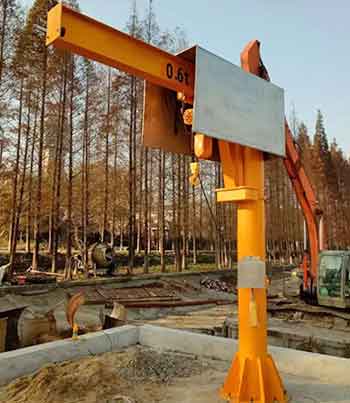
Free standing jib crane with electric chain hoist with rain cover for outdoor use
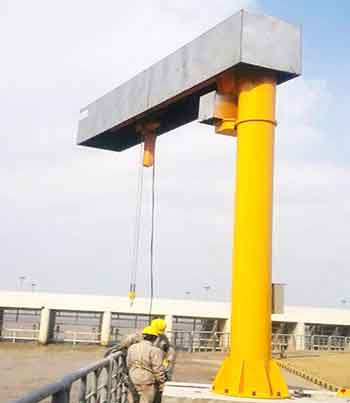
Floor mounted pillar jib crane with full cover over cantilever with electric chain hoist for oudoor use
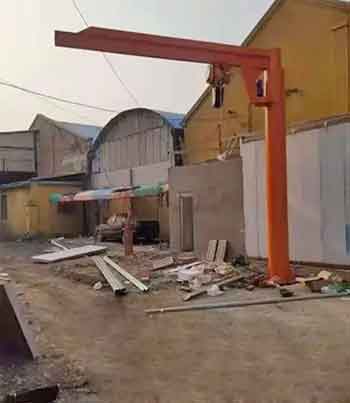
Column mounted jib crane for oudoor door use
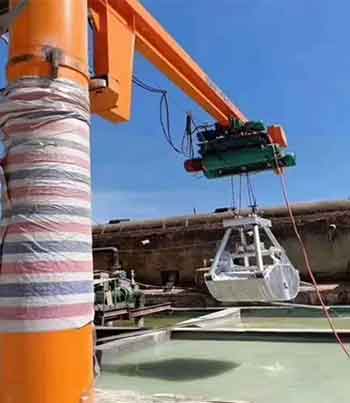
Anti-corrosion jib cranes with grab bucket for outdoor loads handling
Mining and Mineral Processing
Environment: Mining and mineral processing environments are characterized by abrasive conditions, with frequent exposure to dust, moisture, and various chemicals. Equipment in these settings must be robust and durable to handle the demanding conditions and maintain reliable performance.
Applications:
Ore and Material Handling:
- Raw Ore Movement: Efficiently moves raw ores and minerals from extraction points to processing areas. This includes handling bulk materials such as iron ore, copper, and coal.
- Processed Materials: Transfers processed materials and concentrates to storage or further processing stages, supporting smooth operational workflows.
- Material Efficiency: Enhances the efficiency of material handling processes, ensuring timely and accurate movement of materials within the plant.
Equipment Maintenance:
- Heavy Machinery Handling: Lifts and positions large mining machinery such as crushers, mills, and excavators for maintenance and repairs. Provides access for routine servicing and component replacement.
- Maintenance Support: Facilitates the repair and maintenance of critical equipment, reducing downtime and maintaining operational efficiency.
- Safety: Ensures safe handling of heavy machinery, minimizing the risk of accidents and injuries during maintenance operations.
Support in Crushing and Milling:
- Material Transfer: Assists in transferring materials between crushers, mills, and other processing equipment. Supports the movement of both raw materials and finished products.
- Processing Efficiency: Contributes to efficient processing operations by streamlining the transfer of materials within the crushing and milling stages.
- Operational Flexibility: Adapts to various processing needs, including handling different types and sizes of materials.
Functions:
Durability:
- Abrasive Resistance: Designed to withstand abrasive conditions, including exposure to dust and particulate matter. Features rugged construction and corrosion-resistant materials to endure harsh environments.
- Chemical Resistance: Built to resist damage from chemicals commonly used in mining operations, such as acids and reagents.
- Extended Service Life: Enhances durability and longevity, reducing the need for frequent replacements or repairs.
Heavy Load Handling:
- Load Capacity: Capable of managing substantial loads, including heavy machinery and large volumes of material. Equipped to handle the demanding requirements of mining and mineral processing operations.
- High Strength: Constructed with high-strength materials and engineering to support heavy lifting and transportation tasks.
- Operational Efficiency: Ensures effective handling of large and heavy loads, contributing to overall operational efficiency and productivity.
Additional Considerations:
- Safety Features: Includes safety features such as overload protection, emergency stop functions, and safety sensors to ensure secure operation in challenging environments.
- Custom Solutions: Offers customizable options to meet specific needs of mining and mineral processing operations, including specialized lifting attachments and enhanced corrosion protection.
- Compliance: Adheres to industry standards and regulations for safety and performance, ensuring compliance with best practices and legal requirements.
This enhanced description outlines the key roles and functions of anti-corrosion jib cranes in mining and mineral processing, emphasizing their importance in handling heavy loads and operating reliably in abrasive and corrosive environments.
Oil and Gas Refineries
Environment: Oil and gas refineries operate in highly corrosive environments with frequent exposure to petroleum products, chemicals, and extreme temperatures. Equipment must be designed to endure these challenging conditions while maintaining high performance and reliability.
Applications:
Equipment Handling:
- Heavy Equipment: Lifts and positions heavy equipment such as pumps, compressors, and separators. Facilitates the installation, maintenance, and replacement of key refinery components.
- Precision Installation: Ensures accurate placement of equipment to optimize refinery operations and maintain system integrity.
- Operational Support: Provides essential support for ongoing maintenance and upgrades, enhancing overall operational efficiency.
Pipeline Maintenance:
- Pipeline Installation: Assists in the installation of pipelines, which are critical for transporting crude oil, natural gas, and refined products throughout the facility.
- Maintenance and Repairs: Supports maintenance tasks for pipelines, including repairs and replacements, ensuring the integrity and reliability of the pipeline network.
- Access and Mobility: Facilitates access to various sections of the pipeline network, contributing to effective maintenance and operational management.
Chemical Handling:
- Chemical Transfer: Moves drums and containers of chemicals used in refining processes, such as solvents, catalysts, and additives.
- Safe Handling: Ensures safe and efficient handling of hazardous chemicals, reducing the risk of spills and exposure.
- Efficiency: Streamlines the transfer and management of chemicals, supporting continuous refining operations.
Functions:
Extreme Temperature and Corrosion Resistance:
- High-Heat Tolerance: Designed to operate effectively in high-temperature environments typical of refineries. Features materials and coatings that can withstand thermal stress and prevent degradation.
- Corrosion Protection: Constructed with corrosion-resistant materials and protective coatings to endure exposure to petroleum products and corrosive chemicals. Enhances durability and extends equipment life.
- Long-Term Reliability: Maintains performance and reliability in extreme conditions, ensuring minimal operational interruptions and extended equipment lifespan.
Reliable Operation:
- Operational Continuity: Supports critical refinery operations by ensuring reliable performance and minimizing downtime. Designed for high availability and consistent operation under demanding conditions.
- Safety Features: Equipped with advanced safety features such as overload protection, emergency stop functions, and safety sensors to prevent accidents and ensure safe operation in hazardous environments.
- Maintenance Reduction: Reduces the frequency of maintenance interventions due to its robust design, contributing to lower operational costs and improved efficiency.
Additional Considerations:
- Custom Solutions: Offers customizable options to meet specific needs of oil and gas refineries, including specialized lifting attachments and enhanced safety measures tailored to refinery operations.
- Compliance: Adheres to industry standards and regulations for safety, performance, and environmental protection, ensuring compliance with relevant guidelines and best practices.
- Integration: Designed to integrate seamlessly with existing refinery systems and processes, supporting efficient workflow and operational management.
This enhanced description highlights the essential roles and functions of anti-corrosion jib cranes in oil and gas refineries, emphasizing their capability to handle extreme temperatures and corrosive conditions while supporting critical operations with reliability and safety.
Automotive Manufacturing
Environment: Automotive manufacturing facilities often deal with exposure to various lubricants, chemicals, and fluctuating temperatures. The environment demands equipment that is both robust and reliable to handle these challenging conditions while maintaining high performance.
Applications:
Assembly Line Support:
- Part Movement: Moves automotive parts, tools, and equipment along the assembly line to streamline production processes. Supports the efficient transfer of components between different stages of assembly.
- Tool and Equipment Handling: Facilitates the handling and repositioning of tools and machinery required for assembly tasks, ensuring seamless workflow.
- Production Efficiency: Enhances the overall efficiency of the assembly line by ensuring timely and accurate movement of parts and materials.
Maintenance and Repairs:
- Component Lifting: Lifts and positions car components such as engines, transmissions, and chassis for maintenance and repairs. Provides essential support for service and repair tasks.
- Precise Handling: Ensures accurate placement of heavy components during maintenance operations, minimizing the risk of damage and ensuring operational safety.
- Service Support: Contributes to effective servicing and repair of vehicles by providing reliable access to various parts and components.
Handling Raw Materials:
- Material Transfer: Moves raw materials such as steel, aluminum, and other components used in vehicle manufacturing. Supports the efficient transfer of materials to production areas.
- Bulk Material Handling: Manages the movement of bulk materials required for the production of automotive parts, contributing to smooth and efficient manufacturing operations.
- Inventory Management: Assists in the management and organization of raw materials, ensuring a steady supply for manufacturing processes.
Functions:
Precision and Efficiency:
- Smooth Operation: Ensures smooth operation on the assembly line with high timing and accuracy, contributing to a streamlined production process.
- Operational Accuracy: Provides precise control for handling automotive parts and materials, enhancing production efficiency and minimizing errors.
- Workflow Optimization: Supports efficient workflow on the assembly line, optimizing production speed and accuracy.
Corrosion Resistance:
- Chemical Protection: Protects the crane from constant exposure to lubricants, chemicals, and other substances commonly used in automotive manufacturing. Features corrosion-resistant materials and coatings to endure the harsh environment.
- Durability: Enhances the crane's longevity and reliability by reducing the impact of corrosive substances, ensuring consistent performance over time.
- Maintenance Reduction: Reduces the need for frequent maintenance due to its robust anti-corrosion design, lowering operational costs and improving overall efficiency.
Additional Considerations:
- Customizable Features: Offers customizable options to meet specific needs of automotive manufacturing facilities, including specialized attachments and enhanced safety features.
- Integration: Designed to integrate seamlessly with existing production systems and processes, supporting effective management and operation within the manufacturing environment.
- Compliance: Adheres to industry standards and regulations for safety and performance, ensuring compliance with relevant guidelines and best practices in automotive manufacturing.
This enhanced description highlights the critical functions and benefits of anti-corrosion jib cranes in automotive manufacturing, emphasizing their role in supporting assembly line operations, handling raw materials, and maintaining reliability in a chemically challenging environment.
Anti-corrosion jib cranes with capacities from 1 ton to 16 tons are essential in diverse industrial environments. Their robust design enables them to handle a variety of loads efficiently and safely, while their anti-corrosion features ensure durability and reliability in challenging conditions.
Advanced Design of Anti-Corrosion Jib Cranes in Harsh Conditions
Advancements in Anti-Corrosion Technologies
Emerging Materials and Coatings
The field of anti-corrosion technology is rapidly evolving, with several advancements poised to enhance the durability and performance of jib cranes in harsh environments:
- High-Performance Alloys: New alloys and composite materials with superior resistance to corrosion are being developed. These materials offer enhanced strength and longevity, reducing the need for frequent maintenance.
- Advanced Coatings: Innovations in coatings, such as self-healing or nanotechnology-based coatings, provide better protection against rust and degradation. These coatings can automatically repair minor damage and extend the life of the crane.
- Eco-Friendly Treatments: Sustainable and less toxic coating solutions are being introduced, which provide effective corrosion protection while minimizing environmental impact.
Smart Technology Integration
Integrating smart technologies into anti-corrosion jib cranes is transforming their functionality and efficiency:
- Sensors and Monitoring Systems: Advanced sensors can monitor the crane's condition in real-time, detecting early signs of corrosion or wear. This data helps in proactive maintenance and timely interventions.
- Predictive Analytics: Leveraging data analytics and machine learning, predictive maintenance models can forecast potential issues based on historical data and real-time monitoring, optimizing maintenance schedules and reducing downtime.
- Remote Control and Diagnostics: Remote control systems and diagnostic tools allow for easier operation and troubleshooting of cranes from a distance, enhancing operational flexibility and efficiency.
Impact on Industry Practices
Long-Term Benefits and Cost Savings
The adoption of advanced anti-corrosion technologies and smart systems brings several long-term benefits:
- Reduced Maintenance Costs: Enhanced materials and coatings, combined with predictive maintenance, lower the frequency and cost of repairs, leading to significant savings over the crane's lifespan.
- Extended Equipment Life: Improved durability and resistance to harsh conditions result in longer-lasting equipment, which reduces the need for premature replacements and capital expenditures.
- Increased Efficiency: Smart technologies enable more precise operations and faster response times, boosting overall productivity and operational efficiency.
Adaptation to Evolving Environmental Conditions
As environmental conditions continue to evolve, anti-corrosion technologies will play a crucial role in adapting to new challenges:
- Enhanced Protection: Innovations in materials and coatings will provide better protection against emerging environmental threats, such as increased salinity or pollution levels.
- Flexibility: Smart technologies will enable cranes to adjust their operations dynamically in response to changing conditions, ensuring continued performance and safety.
- Sustainability: The development of eco-friendly solutions will help the industry meet stricter environmental regulations and contribute to sustainability goals.
By staying at the forefront of these trends and innovations, the industry can ensure that anti-corrosion jib cranes continue to offer reliable performance and cost-effective solutions in an ever-changing environment.
Customized Anti-corrosion Jib Cranes for Sale
Anti-corrosion jib cranes are specifically designed to excel in challenging environments where traditional cranes might fail. Their use of corrosion-resistant materials and protective coatings helps them withstand harsh conditions such as saltwater exposure, high humidity, and extreme temperatures. This results in enhanced durability, reduced maintenance needs, and prolonged operational life. Their ability to handle various loads with stability and precision makes them ideal for critical tasks in ports and harbors, where reliability is essential.
Choosing the appropriate anti-corrosion jib crane for a given environment is crucial for optimizing performance and ensuring safety. Factors such as the type of cargo, environmental conditions, and operational demands should guide the selection process. By matching crane specifications to these factors, facilities can achieve greater efficiency, minimize downtime, and protect their investment in equipment.
Investing in the latest anti-corrosion technologies not only ensures that cranes remain effective in harsh conditions but also contributes to long-term cost savings and sustainability. By staying informed about these advancements, businesses can make informed decisions and continue to benefit from the robust and reliable performance of anti-corrosion jib cranes.
Main Projects
Related Products

Latest project
32/5 Ton Overhead Crane Sale in India: Case Study
Free consultation to Confirm Parameters & Specifications and Get
Latest Crane Price & Crane Rate.
- Types of overhead cranes : _______?
- Optional: Overhead travelling crane, goliath gantry crane,Slewing jib crane, Single girder or double girder crane,small portable crane or kbk crane, etc.
- Capacity of overhead crane: _______?
- Optional: 0.25ton, 0.5 ton, 1 ton, 2 ton, 3ton, 5 ton, 10 ton,15ton, 20ton, 25 ton, 30ton,35ton, up to 550ton, etc.
- Crane span & lifting height : _______?
- Crane travelling length : _____?
- Control of overhead crane:_______?
- Optional: pendant/ remote/cabin control
- Voltage supply of overhead crane:_____?
- Eg,: 380V50/60HZ,3Phase or others,etc.
- Application/usage of crane:_______?
- Eg,: Steel mill, ,injection mold, cement,stone, concrete,granite, general manufacturing, etc.
Just leave a message via the contact form and our hoist and crane engineer will contact you with in 24working hours.
Get In Touch
